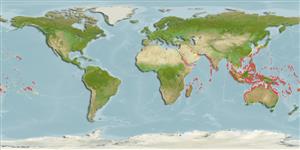Issue
Dascyllus abudafur<> former synonym of this species is resurrected with Indian Ocean distribution and D. aruanus restricted to Pacific Ocean. Information herein will be re-assigned accordingly.
Environment: milieu / climate zone / depth range / distribution range
экология
морской ассоциированный с рифами; немигрирующий; пределы глубины 0 - 20 m (Ref. 9710). Tropical; 38°N - 35°S, 19°E - 124°W
Pacific Ocean: region north and east of Lombok Strait to Line, Marquesan and Tuamoto islands, north to southern Japan, south to New Caledonia.
Length at first maturity / Size / Вес / Возраст
Maturity: Lm 5.0 range ? - ? cm
Max length : 10.0 cm TL самец/пол неопределен; (Ref. 4391); common length : 6.0 cm TL самец/пол неопределен; (Ref. 5450); наибольший возраст (опубликованны данные): 6 годы (Ref. 72479)
колючие лучи спинного плавника (общее число): 12; членистые (мягкие) лучи спинного плавника (общее число): 11-13; колючие лучи анального плавника 2; членистые (мягкие) лучи анального плавника: 11 - 13. Color in life white with 3 black bars; a large brown spot on dorsal part of snout and interorbital; lips dusky or white; caudal fin pale; pelvic fins black; pectorals transparent. Margins of preorbital, suborbital, and preoperculum finely serrated (Ref. 2746). Body depth 1.5-1.7 in SL (Ref. 90102).
Territorial, inhabit shallow lagoon and subtidal reef flats. Form large aggregations above staghorn Acropora thickets or in smaller groups above isolated coral heads. Feed on zooplankton, benthic invertebrates, and algae. Males invite females to spawn in their nests; protecting the eggs until they hatch and becoming very aggressive against other fish. Eggs hatch after 3-5 days; pelagic larvae feed on plankton (Ref. 5503). Oviparous, distinct pairing during breeding (Ref. 205). Used in behavioral study. Have been reared in captivity (Ref. 35412). Diurnal species (Ref. 54980, 120737).
Male selects and protects the nest; does the courtship `dance' about 1 m above the nest and escorts the attracted female to the nest site where spawning ensues (Ref. 33146). Oviparous, distinct pairing during breeding (Ref. 205). Eggs are demersal and adhere to the substrate (Ref. 205). Also Ref. 103751.
Borsa, P., A. Sembiring, C. Fauvelot and W.-J. Chen, 2014. Resurrection of Indian Ocean humbug damselfish, Dascyllus abudafur (Forsskål) from synonymy with its Pacific Ocean sibling, Dascyllus aruanus (L.). Comptes Rendus Biologies, Elsevier Masson, 337(709-716). (Ref. 119133)
Статус Красного Списка МСОП (Ref. 130435)
Угроза для людей
Harmless
Использование человеком
рыболовство: интереса не представляет; аквариум: коммерческий
дополнительная информация
ссылкиаквакультура (рыбоводство)особенности рыбоводствастепень растяжениягенетикаElectrophoresesнаследуемостьболезниобработкаNutrientsMass conversion
инструменты
Специальные отчеты
Скачать в формате XML
ресурсы в Интернет
Estimates based on models
Preferred temperature (Ref.
123201): 24.9 - 29.3, mean 28.4 °C (based on 2883 cells).
Phylogenetic diversity index (Ref.
82804): PD
50 = 0.5005 [Uniqueness, from 0.5 = low to 2.0 = high].
Bayesian length-weight: a=0.02239 (0.01732 - 0.02894), b=2.95 (2.88 - 3.02), in cm total length, based on LWR estimates for this species (Ref.
93245).
Trophic level (Ref.
69278): 3.3 ±0.42 se; based on food items.
устойчивость к внешним воздействиям (Ref.
120179): средний (среднего размера), минимальное время удвоения популяции 1.4-4.4 года (tmax=6; Fec=1,500-2,000).
Fishing Vulnerability (Ref.
59153): Low vulnerability (10 of 100).
Nutrients (Ref.
124155): Calcium = 110 [52, 178] mg/100g; Iron = 0.796 [0.461, 1.348] mg/100g; Protein = 18.2 [17.0, 19.3] %; Omega3 = 0.117 [0.065, 0.201] g/100g; Selenium = 19.4 [9.7, 40.5] μg/100g; VitaminA = 185 [52, 631] μg/100g; Zinc = 1.52 [0.99, 2.25] mg/100g (wet weight);
